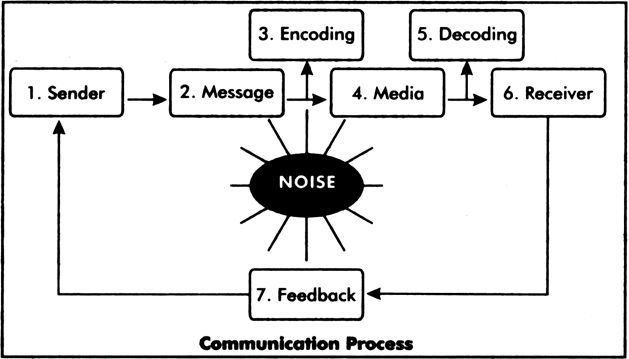Directing
State the steps involved in the process of communication.
Communication process has been shown in the following diagram:
(i) Sender/Communicator: Sender is the person who sends his ideas to another person.
(ii) Message: It includes opinion, feelings, views, attitude, orders, suggestion, etc. For example, the work plan to be explained by the manager is in the shape of ideas.
(iii) Encoding: Anything thought about by the sender is a mental state, which means that something to be communicated has been thought of. Communicating this idea or thinking with the help of symbols, words or diagrams is called encoding.
(iv) Media/Transmission: A person who is anxious to send a message has to make use of some medium for communication. There can be many media of communication like face-to-face conversation, letters, internet chatting, telephone, E-mail, symbols, etc. During the transmission of a message it is very important to keep the media of transmission free from noise.
(v) Decoding: The sender can send his ideas briefly in the form of symbols or diagrams. Understanding it correctly is called decoding.
(vi) Receiver: A receiver is a person for whom the message is sent.
(vii) Feedback: Feedback is a signal pointing out to what extent the receiver has really received and understood the sender's message correctly.
(viii) Noise: Noise is the hindrance in the process of communication. It creates hurdle in the way of conversation. It can take place at any step in the communication process.
Sponsor Area
Some More Questions From Directing Chapter
What is directing? Discuss its importance.
“Directing is the heart of the management process”. Do you agree? Give any four reasons in support of your answer.
‘Directing is not required at all in management of an organisation.’ Do you agree?
“Direction is the least important function of management”. Do you agree with this statement? Give any two reasons in support of your answer.
Enumerate any two features of directing.
How does the directing function bring about balance in the organisation?
Clarify the difference between Managing and Directing.
Which function of management is known as ‘Management-in-action’?
Out of managing and directing, which term has the wider scope?
Which factor of production is Directing related to?
Mock Test Series
Sponsor Area
NCERT Book Store
NCERT Sample Papers
Sponsor Area